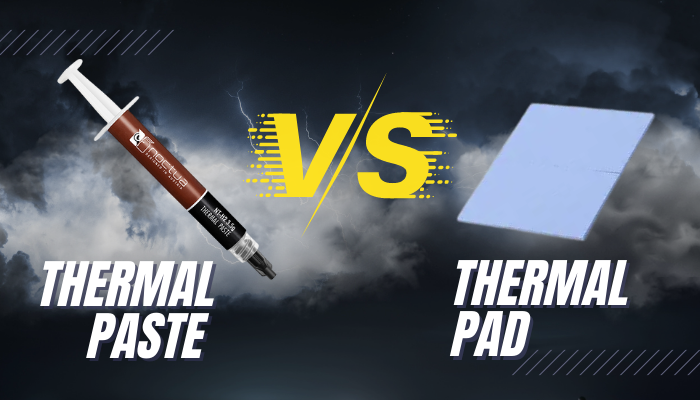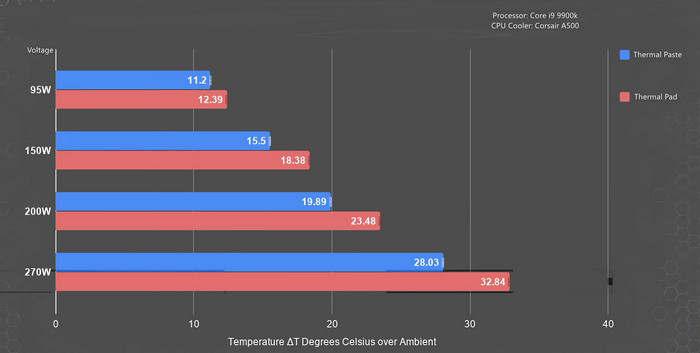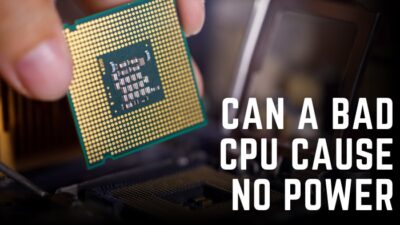Thermal paste and pads are two typical thermal conductive components used in electrical devices to transfer heat from a heat source to an absorber plate. Both elements serve the same purpose, but these materials vary in structure, efficiency, and implementation.
Here, I will examine the distinctions between thermal paste and thermal pads and their benefits and drawbacks.
Let’s get started.
What is the Difference Between Thermal Paste & Thermal Pad?
Thermal paste is a gelatinous material to ease heat transfer between the heat-generating element and the heat sink. Alternatively, thermal pads are thick pieces of sheet. This sheet has been pre-cut and placed between the heat-generating part and the absorber plate.
There are other differences between thermal paste and thermal pads. You can find out more by reading the section below.
Here are some differences between thermal paste and thermal pad:
| Thermal Paste | Thermal Pad |
|---|---|
| A sticky material used between the heat-producing component and the heat sink. | A thermal pad is a pre-cut solid portion of material placed between the heat-producing element and the heat sink. |
| Putting thermal paste can be sloppy and needs a firmer grip. | Simple to use and does not necessitate any special tools or skills. |
| Thermal paste has a better thermal permeability than thermal pads. | Thermal pads have lesser heat capacity than thermal paste. |
| Thermal paste is more effective than thermal pads, filling tiny spaces between the contacting surfaces. | Thermal pads have a defined surface area and may not be appropriate for all equipment or heat sinks. |
| It can wear out and lose its efficacy over time. | It does not deteriorate as they age. |
What are Thermal Interface Materials (TIM)?
Thermal Interface Materials (TIM) improve heat transmission between contacting surfaces. Every kind of electric device, mobile phone, and video game console are just a few examples of electronic-based products that contain thermal materials.
When two plates make contact, the areas typically have tiny voids and irregularities that prohibit direct interaction. These spaces serve as separators, preventing heat from transferring from one place to another.
Thermal conductive materials fill these gaps and establish a path for heat transfer to solve the heating problem.
Numerous materials, such as metals, ceramics, polymers, and alloys, can be used to create TIM. The heat conductivity and use are taken into account when selecting the material.
For instance, due to their exceptional heat removal power, thermal interface materials such as thermal pastes, greases, and pads are frequently used in electrical gadgets.
There are various types of thermal interface materials available. Just follow the section below to know more.
The following are some examples of popular thermal interface materials:
- Thermal Pad.
- Thermal Grease.
- Heat Spreader.
- Thermal Paste.
- Thermal Gel.
- Dielectric Pad.
- Thermal Compound.
Follow our guide to remove Thermal Paste off CPU Pins.
What are the Pros & Cons of Thermal Paste & Thermal Pad?
Thermal paste has proven to be highly dependable in a range of situations. The paste is easy to use, covers irregular gaps, and provides a much narrower interface for better heat transfer. Alternatively, a thermal pad is not as soft as a thermal paste and cannot cover tiny gaps.
Typically, silicone, metal oxides, and other substances with high thermal permeability are combined to create a thermal paste.
Thermal paste has a few advantages and disadvantages. Simply read the part below to find out.
The benefits and drawbacks of thermal paste are as follows:
- »Thermal paste has higher thermal permeability than thermal pads, resulting in more effective heat exchange.
- »Thermal paste can cover tiny spaces between the contacting materials better than thermal pads, providing optimum friction and heat transmission.
- »Thermal paste application can be untidy and needs a firm hand.
- »Overuse of thermal paste can cause short circuits or parts damage.
- »Thermal paste can fade out and lose its effectiveness over time.
Thermal pads are usually composed of silicone and have a lower temperature conductivity than thermal paste. These thermal pads have some advantages and disadvantages. To learn more, simply read the part below.
Here are some pros and cons of thermal pads:
- »Thermal pads are simple to install and do not involve specific tools or knowledge.
- »Thermal pads don’t lose efficacy and do not wear out like a thermal paste.
- »Thermal pads have poorer heat capacity than thermal paste, resulting in inefficient heat exchange.
- »Thermal pads have a defined diameter and might not be appropriate for all equipment or heat sinks.
Thermal Paste vs Thermal Pads Benchmark
Whereas thermal pads are excellent at heat exchange substances, their rigid nature prevents them from covering all empty spaces as thermal paste would. Therefore, thermal pads do not use crucial hot elements such as Processors, Graphics cards, or CMOS.

We will use an Intel Core i9 9900k CPU with a Corsair A500 cooler for temperature testing our system. For thermal conductivity, we will use thermal paste in one device and thermal pads in the other.
According to the temperature benchmark, we can see that when it comes to temperature control, the thermal paste is always way ahead of the thermal pad at various voltages. We can see that thermal paste is 12-14% more efficient than thermal pads at maintaining a low temperature.
Conclusion
Thermal paste and thermal pads are efficient thermal interaction materials for transferring heat from a heat source to a heat sink. The choice between the two depends on the specific purpose and the user’s preferences. They both have advantages and disadvantages.
Regardless of the option, using a thermal interface material is critical for avoiding overheating and ensuring the durability of digital equipment.




